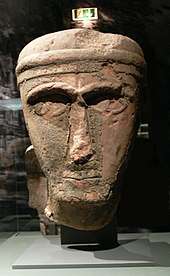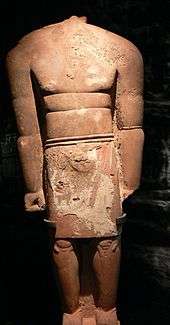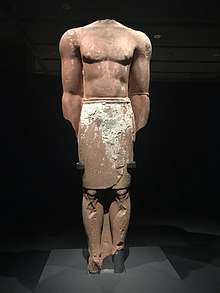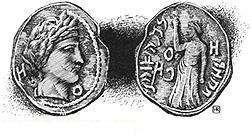Lihyan

Lihyan (Arabic: لحيان) (Greek: Lechienoi)[1] or Dadan or Dedan was a powerful and highly organized ancient Arabian kingdom that played a vital cultural and economic role in the north-western region of the Arabian Peninsula.[2] The Lihyanites ruled over large domain from Yathrib in the south and parts of the Levant in the north.[3] In antiquity, Gulf of Aqaba used to be called Gulf of Lihyan. A testimony to the extensive influence that Lihyan acquired.[4] Dedanite is used for the older phase of the history of this kingdom since their capital name was Dedan (see Biblical Dedan), which is now called Al-`Ula oasis located in northwestern Arabia, some 110 km southwest of Teima.
The Lihyanites later became the enemies of the Nabataeans. The Romans invaded the Nabataeans and destroyed their kingdom in 106 AD. This encouraged the Lihyanites to establish an independent kingdom to manage their country. This was headed by the King (Timmy), one of the former royal family, which governed Al-Hijr before the Nabataean invasion.
The Arab genealogies consider the Banu Lihyan to be descended from the Ishmaelite Arabs from Ishmael. The descendants of Lihyan founded the Arab kingdom of Lihyan, and presently live in the desert between Mecca and Jeddah.
History


The primary evidence for the kingdom comes from the corpus of inscriptions in the capital Dedan and surrounding area. The dating of the rulers and dynasty is a matter of dispute and controversy in the academic sphere. The Lihyanite kingdom went through three different stages, the early phase of Lihyan Kingdom was around the end of the 7th century BC, started as a Sheikdom of Dedan then developed into the Kingdom of Lihyan tribe.[5] The earliest attestation of state regality, King of Lihyan, was in the mid-sixth century BC.[6] Based on current chronological scheme, it is in the early stage of Lihyan (i.e., Dedanite period) that the Lihyanite writing system (similar to the Thamudic script, and consisted of 28 letters) emerged. initially simple in form, then evolved during later stage. The second stage of the kingdom saw the transformation of Dedan from a mere city-state of which only influence they exerted was inside their city walls, to a kingdom that encompass much wider domain that marked the pinnacle of Lihyan civilization.[7] The third state occurred during the early 3rd century BC with bursting economic activity between the south and north that made Lihyan acquire large influence suitable to its strategic position on the Caravan Road.
It appears, from recent epigraphic publications, that Lihyan controlled their trade rival Tayma (a fertile and rich oasis in North Arabia) for several generations.[8] The hostility between the two oases is reflected by an inscription from Tayma that mention a war between them. After the Lihyanite annexation of Tayma, the Lihyanite kings may have visited the city to commemorate their rule on regular basis. Indeed, standing statues larger than human stature with legs aligned and hands hanging down, supposedly of Lihyanite kings, were found in the temple of Tayma. Probably as a reminder of the population subordination to the king of Dedan. The statues correspond with similar royal statues from Dedan, which display standardized artistic model of dignitary sculpting. Thus suggesting the role of Dedan as a regional power.[9]
Dedan is mentioned in Harran Stele, and in Biblical accounts as an important centre of trade. Which is considered by some authors as an indicator of the existence of well organized state in the region before the mid 1st millennium BC. In the Biblical records, Dedan is mentioned alongside Tayma and Saba, but more often connected with Qedar. The kings of Lihyan were possibly the descendants of the Qedarites,[10] and had a close contacts with the Ptolemaic dynasty.
The oldest reference to Lihyan (Lhyn) comes from early Sabaean inscription dated to the first half of the sixth century BC that records the journey of a Sabaean merchant. He intended to go to Cyprus for trade, and on his way he passed through Dedan, the "cities of Judah", and Gaza.[11]
Fall

Some authors assert that the Lihyanites fell into the hands of the Nabataeans around 65 BC upon their seizure of Hegra then marching to Tayma, and finally to their capital Dedan in 9 BC. Werner Cascel consider the Nabataean annexation of Lihyan was around 24 BC, he inferred his opinion from two factors; The first, Cascel relied on Strabo accounts of the disastrous Roman expedition on Yemen that was lead by Aelius Gallus from 26 to 24 BC. Strabo made no mention of any independent polity called Lihyan. The second, is an inscription which mention the Nabataean king Aretas IV found on a tomb in Hegra (dated around 9 BC) substantiate that the territories of Lihyan was already conquered by the Nabataeans under the reign of Aretas IV. Nearly half a century later based on an inscription from certain Nabataean general who used Hegra as his HQ, mentioned the installation of Nabataean soldiers in Dedan the capital of Lihyan.
The Nabataean rule over Lihyan ended with the annexation of Nabatea by the Romans in 106 AD. Although the Romans annexed most of the Nabataean Kingdom, they did not however reach the territories of Dedan. The Roman legionaries that escorted the carvans end 10 km before Dedan, the former boundary between Lihyan and Nabatea. The Lihyanites restored their independence under the rule of Han'as ibn Tilmi, who was from the former royal family before the Nabataean invasion. His name is recorded by a craftsman who dated his tomb carving to the fifth year of Han'as ibn Tilmi reign.
Governance
The Lihyanite kingdom was a monarchy that followed a heredity succession system. The kingdom's bureaucracy represented by the Hajbal members, similar to the people's council in our modern time, used to aid the king in his daily duties and took care of certain state affairs on behalf of the king.[12] This public nature of the Lihyanite legal system is shared with that of south Arabia.[13]
The Lihyanite rulers were of great importance in the Lihyanite society, as religious offerings and events were generally dated according to the years of king reign. Sometimes regnal titles were used; such as Dhi Aslan (King of the Mountains) and Dhi Manen (Robust King).[14] Also religion played a significant role and was, along with the king, a source of legislation. Under the king there was a religious clergy headed by the Afkal, which appears to be inherently passed position.[15] The term was borrowed by the Nabataeans directly from the Lihyanites.[16]
Other state occupations that were recorded in Lihyanite inscriptions was the position of Salh (Salha for a female); mostly occurs before the name of the supreme Lihyanite deity Dhu-Ghabat (meaning the delegate of Dhu-Ghabat). The Salh was responsible for collecting taxes and alms from the followers of the god.[17] "Tahal" (a share of the taxes) which equals one tenth of the riches was dedicated to the deities.[18]
Post-Nabataean Lihyanite kings were less powerful in comparison to their former predecessors, as the Hajbal exercised greater influence on the state, to the point where the king was virtually a figurehead and the real power was held by the Hajbal.[19]
Literature
- Lozachmeur, H (ed.) 1995. Présence arabe dans le croissant fertile avant l'Hégire. (Actes de la table ronde internationale Paris, 13 Novembre 1993). Paris: Éditions Recherche sur les Civilisations. pp. 148. ISBN 2-86538-254-0.
- Werner Caskel, Lihyan und Lihyanisch (1954)
- F.V. Winnett "A Study of the Lihyanite and Thamudic Inscriptions", University of Toronto Press, Oriental Series No. 3.
- Lynn M. Hilton, Hope A. Hilton (1996) "Discovering Lehi". Cedar Fort. ISBN 1462126383.
See also
References
- ↑ "Liḥyān - ANCIENT KINGDOM, ARABIA". Britannica. Retrieved 7 March 2017.
- ↑ Rohmer, J. & Charloux, G. (2015), "From Liyan to the Nabataeans: Dating the End of the Iron Age in Northwestern Arabia" - p. 297
- ↑ Saudi Arabia Tourism Guide
- ↑ Discovering Lehi. Cedar Fort; 9 August 1996. ISBN 978-1-4621-2638-5. p. 153.
- ↑ The State of Lihyan: A New Perspective - p. 192
- ↑ J. Schiettecatte: The political map of Arabia and the Middle East in the third century AD revealed by a Sabaean inscription - p. 183
- ↑ The State of Lihyan: A New Perspective - p. 192
- ↑ A Companion to the Archaeology of the Ancient Near East. John Wiley & Sons. p. 825. ISBN 978-1-4051-8988-0.
- ↑ A Companion to the Archaeology of the Ancient Near East. John Wiley & Sons. p. 825. ISBN 978-1-4051-8988-0.
- ↑ Cross, A New Aramaic Stele from Tayma, p.392
- ↑ Rohmer, J. & Charloux, G. (2015), "From Liyan to the Nabataeans: Dating the End of the Iron Age in Northwestern Arabia" - p. 302
- ↑ Thomas Kummert: (Dedan - Khuraibah) Early Ancient Kingdom and Trading Oasis on Incense Route - p.2
- ↑ Werner Caskel on Ancient Lihyan p.4
- ↑ نقوش لحيانية من منطقة العلا د. حسين بن علي p.328
- ↑ Jawad Ali: The history of the Arabs before Islam - p. 425
- ↑ Healey, J. 1993: p.36-37
- ↑ نقوش لحيانية من منطقة العلا د. حسين بن علي p. 326-327
- ↑ Roads of Arabia p.272
- ↑ Jawad Ali: The history of the Arabs before Islam - p. 338